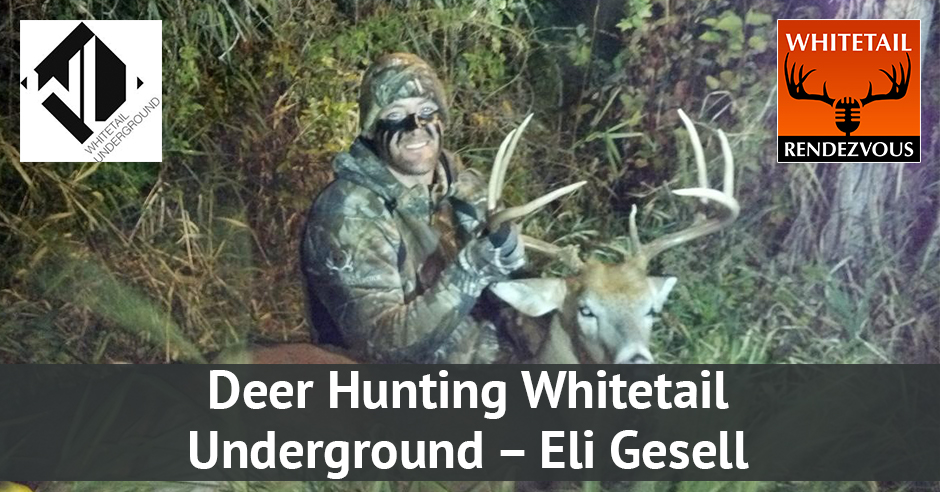
Tracking your experiences is an excellent way of sharing your journey to people. Experienced hunter Eli Gesell shares his hunting journey through his website Whitetail Underground and on his social media accounts. Through his platforms, Eli wants to share his insights for those who hunt for public and small tracts of land. As Eli talks about the importance of scouting and thermals in hunting, he reveals his hunting styles and preparations in this episode.
—
Listen to the podcast here:
Deer Hunting Whitetail Underground – Eli Gesell
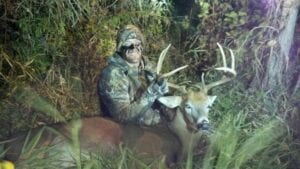 Eli was on the show and he sent me an email, called me up and said, “I want to talk more about Whitetail Underground and what that means to me.” That’s how we’re going to start the show. Eli Gesell is from North Central Minnesota and he is one heck of a swamp buck hunter. He’ll talk about those stories. Eli, welcome back to the show and let’s start right where you want to start the show off with Whitetail Underground. Let’s talk about how it began, what it offers and why people should take a look at it.
Eli was on the show and he sent me an email, called me up and said, “I want to talk more about Whitetail Underground and what that means to me.” That’s how we’re going to start the show. Eli Gesell is from North Central Minnesota and he is one heck of a swamp buck hunter. He’ll talk about those stories. Eli, welcome back to the show and let’s start right where you want to start the show off with Whitetail Underground. Let’s talk about how it began, what it offers and why people should take a look at it.
It began as me not wanting ever to look back and say, “I wish I would’ve tried to turn something that I’m passionate with into a career.” There’s a couple of things in my life that I look back and say, “What if and why didn’t you try?” I didn’t want this to be one of those things. I almost died of carbon monoxide poisoning. That’s what fueled the drive to want to try and make this work. The name Whitetail Underground, I feel like what’s represented in hunting media’s not normal for everybody. What you can watch, nobody has. The underground part of hunting is what everybody’s able to do. We don’t all have big tracks of land. We all can’t hunt highly managed properties. Most of us are on public land and small parcels that we have permission on for free. No big leases. That’s why I chose that name. I thought that I could put out some material that’s relatable to people, share some stories that I have from our home here and hope that people would follow along and I can maybe turn this into something bigger someday.
The background was you wanted to have your own reality show on your blog.
I don’t know if the way reality shows are looked at as maybe the right term but to be able to do some freelance writing maybe and have some video content that I’m able to put out. Maybe turn that into a full-time gig.
What I meant by that you’re keeping it real. Not with the drama of The Bachelor but, “Here it is. Down and dirty, here’s what I have to do. Here’s walking in at 4:30 in the morning and here’s how I have to put up my step.” Here’s the real deal. This isn’t like, “I’ve got groomed farms.” Some people are fortunate to hunt groom farms where there are trails all over. There are food plots right to their tree stand. It’s very well set up and they kill a lot of deer. There’s nothing wrong with doing that but a lot of us don’t have that ability. One is money, two is time, and three we don’t own the land. We’re guests. The farm I hunt, I’m a guest and I do a little bit here, do a little bit there, try to put it in some plots or put in some kill plots. Other than that, it’s the corn and bean farm with some alfalfa, alfalfa spurs cattle, cows, the corns for the cows and the beans. He sows up his beans but having said that, I’m a guest and even if we run public land, we’re guests. Let’s go back and talk about where you want Whitetail Underground to go. How are you going to make it grow?
I want it to end up someday where it’s what I do for a job. I don’t want it to feel like a job. If it turns into even like a job, I failed along the way at some point. It’s something I’m passionate about and hopefully, the content that I put out is relatable to enough people, being myself and a normal guy that I’m able to grow it by being myself.
If you can turn a weakness into a strength, you're going to become a better and more efficient of hunter. Share on XHow do you plan to grow it? If somebody wants to ask you questions, how do you interact with people?
I’m on social media quite a bit. If anybody asks me any questions, I try and respond as soon as I can. I have daily questions I ask on Facebook and we interact with quite a few people each day. The last couple of months, I’ve had a big uptick and interaction with a lot of people. The Facebook page is starting to pick up and the YouTube page has picked up a fair amount of subscribers, more than I anticipated in this short little time.
How do people find you on Facebook, YouTube and Instagram?
Our YouTube is Whitetail Underground Productions, @Whitetail_Underground on Instagram and Whitetail Underground on Facebook.
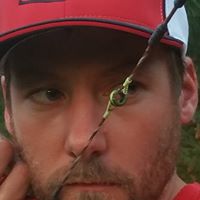 Reach out to that and Eli wants to hear. He wants to grow your knowledge of whitetails and he wants to grow his business and we can do that if he interacts and develops some relationships with you guys and gals. What questions are people asking you?
Reach out to that and Eli wants to hear. He wants to grow your knowledge of whitetails and he wants to grow his business and we can do that if he interacts and develops some relationships with you guys and gals. What questions are people asking you?
There’s a lot of tactical questions. I asked the question about, “What is your biggest weakness as a hunter?” With people responding to that, that spurs other questions that people answer each other and I talked back and forth with. It’s a fun way to interact with people around the country. I feel that we grow as a community like that when we can have a good conversation with each other, especially stuff like weakness. If you can turn a weakness into a strength, you’re going to become that much better and more efficient of a hunter.
For you to become a better hunter, what do you have to do?
We have to look at each situation that happens in the woods and try and figure out why it happened. If you see a mature buck moving across the landscape, you got to try and figure out where he’s moving to, why he’s moving and where he comes from. If it takes getting down, finding where that buck was bedded, that’s something that we’ve got to do. You always have to be learning at all times and never pass anything off as chance or forget about something that happened. We always have to try and figure out why.
One thing I learned from one of the guests, you’re long distance scouting. You’d see a buck come out and you watch them go over the hill. That’s a perfect time to backtrack and go find his bedding area because he’s not there. The probability of another buck being in his bed or bedding area, it’s slim, it could happen. You see them out in the field in a group by July and August, it happens but they’re out together. You might say, “They’re bedding in the same general area.” If one buck’s out during the summertime, they’re all out. You go back and you won’t find one bed, you’ll find a series of beds within acres.
It’s not going to be a large area depending on the terrain. If you were in Kansas, in some place, it’s a little bit different but I’m talking Wisconsin, Iowa, Kentucky, Ohio and Missouri, we have good cover. That’s one trick you can see and say, “This is where he’s coming from.” You’re completely away from him. You let the deer go. The second part of that, once you find a bedding area and get that posted down, you stay out of there and then you watch them. You get back in his feeding routes or feeding patterns and there’s something to be said about that. Where do you think about that suggestion?
That’s exactly what I was alluding to. Once you pinpoint where that bed is, you’re able to locate their exit routes too whether it’s the water or maybe they’re getting up to move because the wind switched and they don’t like where they’re at. They don’t have wind advantage and there’s maybe an extra trail to a spot there or they’re feeding. Once you find them in exit trails and their food source or a secondary bedding area that they like on pretty common wind, that’s stuff that we can find. Pinpoint trees that we can set up in during the hunting season. I have a couple of trips planned out to public land that I hunt quite a bit. I’m going to do a couple of observation sits there before our season gets rolling here in Minnesota and hopefully I can pick up on some of that early season movement.
If you're too prepared, nothing's going to happen. If you can short yourself on the necessities, you're probably going to have better luck. Share on XKey phrase, observation sits for deer hunting. If you’re a deer hunter, it isn’t all about getting the rifle before opening, go to the range, go to the backyard, shoot a couple of shells, get packed up and go to the cabin. I said that wrong. It could be that that’s your hunt and if that’s your hunt, the hunting tradition is you hunt the nine or five days, whatever your season is and you have a great time at the cabin. There are some of us that we do that plus we’re 365-day hunters. There’s a difference. In the show, somebody brought this up and said, “Bruce, everybody’s not as insane as you are about hunting whitetail deer nor your guests.” I said, “I get it.”
If you’re that person that takes the rifle out one time a year, goes hunting, has a great time at camp and tell stories, that’s worthwhile to anybody because you’re hunting. You won’t hear a lot of stories about that because the people I’ve talked to are 365, 24/7 deer hunters. We’re pretty much insane or passionate or whatever you want to call it. We’re focused on figuring out, “How do I figure out this deer? How do I get this deer? What do I have to do to get in that deer’s head?” I have a choice of harvesting him, killing him and putting him on the ground and eating him or not. That’s my thought. What’s your thought on what I said?
I agree with it 100%. If you’re strictly a gun hunter that goes up to the family cabin, that’s some of the best camaraderie that you’re ever going to be around. That’s where a lot of us started. We don’t have a hunting cabin but the family rifle hunting, when I was a kid, was some of the best memories that I’ve ever had. It’s turned into something that’s consumed me. I get caught at work thinking about bedding areas, transition routes, stand setups and what I need to do yet. I’m scared when our archery season opens up because I’m not ready. You hit the nail on the head with every point you brought up.
Thanks for that. This series, everything I’m doing is for prepping and getting ready. What are some of the other things that you’re doing? When you hit opening morning, you’d know you’re ready. You’re confident and you’re ready to go.
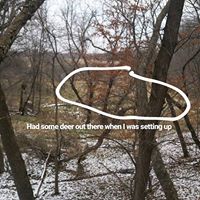 I’m still scouting. That’s the key, especially into this style of hunting that I’ve adopted. I’m trying to shoot my bow every day. I got a fourteen-year-old and an eleven-year-old that play baseball and we’re running around the countryside five to eight games a week. That limits my time. I shoot my bow all the time and going over my gear, making sure my boots are good, making sure my stand’s set up good and quiet, covering anything that’s making any noise and I’d be replacing bolts. I’m doing a lot of scouting on the computer, trying to find new public areas that I can get to, running trail cameras at the farms that I have permission to hunt at and run in mineral. That’s one thing too that helps with the cameras and gets deer in front of the cameras quite a bit. I always try to learn something, whether it’s something to do with my gear or with the deer that we pursue and I try to learn something every day.
I’m still scouting. That’s the key, especially into this style of hunting that I’ve adopted. I’m trying to shoot my bow every day. I got a fourteen-year-old and an eleven-year-old that play baseball and we’re running around the countryside five to eight games a week. That limits my time. I shoot my bow all the time and going over my gear, making sure my boots are good, making sure my stand’s set up good and quiet, covering anything that’s making any noise and I’d be replacing bolts. I’m doing a lot of scouting on the computer, trying to find new public areas that I can get to, running trail cameras at the farms that I have permission to hunt at and run in mineral. That’s one thing too that helps with the cameras and gets deer in front of the cameras quite a bit. I always try to learn something, whether it’s something to do with my gear or with the deer that we pursue and I try to learn something every day.
You mentioned something about playing baseball and going here and going there. When you’re sitting there in the stand and talking to all the parents, people that you don’t know, somehow winding around and say, “Anybody around here a deer hunter? I love to archery hunt,” and see what they’ll say because every single game there’s that one person if you could get to them, they’re as crazy about it as you are and maybe you’d develop a relationship.
There’s a good possibility. The community that I live in, it’s pretty small and there’s a lot of hunters here. I wouldn’t doubt that something could spur from a conversation like that at one of those games.
Even if you start talking to people and say, “I love to archery hunt. I want to meet some guys and gals who love to archery hunt. I’ll have some beer at my house, you’re welcome to come over and we’ll celebrate the kids’ baseball season.” You mentioned about the hunting tradition, especially in Wisconsin, nine-day season, the stump sitters created deer hunting. It’s legends in the stories that have come up from the Upper Peninsula, the Yoopers in Upper Wisconsin. I sit in some of these tiny cabins and you wouldn’t believe the people that I met there. They were no different than the rest of us, but they were businessmen in the state. Even some football players, they love whitetail hunting and they were off doing what they could do for one day or all of the whole season didn’t matter.
I missed that because the way I hunt now and so many places, you blast in and out and you don’t have the home court. We do in Wisconsin. There’s a bunkhouse crew but we’re getting older and it’s harder. Building a community is important. When we look at being a student of whitetails, I learned things that I’d never knew about whitetail deer. One thing that is known is deer are colorblind. No, they’re not. They see blues well and blues turn into white and whites in the middle of the night scare the crap out of them plus if you were blue jeans and use brighteners on them, you glow in the dark. You look like you’re a ghost walking through the dark. If a deer sees you walking through the dark, do you think they’re going to stick around? No. It’s little things like that. Did you know about UV rays, brighteners and blue hues?
I’ve known they can see the UV rays and stuff, but nobody put it into terms that I can understand like what you did. I know that there was a product that was advertised in Field & Stream and Outdoor Life that was a UV blocker. I’ve never purchased any because it’s one of those things that you read about or hear about it and you maybe pass it off as BS.
It's nice to have high goals, but you don't want to be disappointed at the end of the day either. Share on XThere are a lot of companies out there, Atsko’s Sno-Seal and Pure One UV killers. If you have any blue hues in your gear, your hat, your face mask, your pants, your gloves, anything, you are a walking billboard for whitetail deer. If you put up blue tape to mark your exit-entrance, take that blue tape down. Blue survey tape is not your friend in the woods. It’s a sign, “Go away. Humans are here.” This is a big white stripe like a neon sign. I went to my property and I walked in. We had some blue survey tape up right at a crossing, fairly coming through the fence. Those are the things you learn by being a student. What are some of the things that you’ve learned by being a student? What are some of the things that you’ve learned about whitetail deer, where it wants you to become more and more of a student, not just a hunter but a student of the deer?
They always use the winds and they’re not doing anything by chance. There’s always a reason behind anything that they’re doing. The way the thermals roll through the land and the reason that the trails are where they’re at is because those deer are using the thermals to be able to see and smell anything from a couple of different directions, especially in a hilly terrain or rough counties like the Buffalo County, Wisconsin area and the Rochester, Minnesota area. In the morning when the thermals are rising and the wind is coming over the top of the hill, they were able to smell things from two different directions as they’re headed at that top one-third of a hill. That’s something that I’ve learned here in the last couple of years and not something that I had never ever would have dreamt of thinking about until I tried to up my knowledge level to be able to get in front of more of these mature animals.
Some people sit on waterholes and one thing about waterholes, especially if you’re out west hunting antelope, the wind bounces because waterholes, it’s a tank down. The wind’s coming across the prairie hits the brim or the berm and then bounces. It can go right over the head of the game you’re trying to get. The guy said, “That’s why you can be set up here and you don’t have to be set up here but you shouldn’t set up there because this is what’s going to happen.” Paying attention to the wind, we all know it. Keep the wind in your face but you’re hunting in the mountains as I do, you’re sometimes screwed because the wind’s so squirrely. In the Midwestern states, it’s not as drastic but you still have to play the wind. You can be out there butt naked with no jeans and plaid shirt and play the wind right. You can kill a deer.
Something that Dan and Phil talk about a lot going back through your water tank comment is here in the Midwest it’s calm and that water has warmed up. It’s going to push your scent in areas where you want to think about it, too. If you’re set up on a waterhole, you have to be set up in the right tree to where your wind’s not going to go to where those deer are coming onto the water. It’s something that I would’ve never ever thought of until I watched the video that he put together. He’s up on a stand and he’s dropping milkweed and that water’s sucking in his scent against the wind. The thermal was so strong from the water.
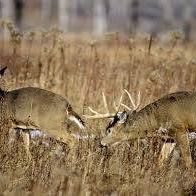 You’re a big student of Dan Infalt, are you?
You’re a big student of Dan Infalt, are you?
Yeah, I can’t get enough of Dan’s thought process and how he’s able to get stuff done. Mostly because he does it on public land where everybody else has a chance to do the same thing and he’s still able to out hunt everybody around him.
What are the top three things that you’ve learned from reading his stuff or watching videos? What would it be?
The thermals part of it. It’s a big thing. How to look for overlooked areas and a lot of times it’s not going in deeper than a lot of people but to pay attention to things that most people would pass off as something that doesn’t look like it’s going to hold deer. Another thing is you always need to be paying attention to the wind and the scent control thing. A lot of it is BS stuff that’s good at separating people from their money but not very good at putting deer in the back of the truck. Dan Infalt runs a site called The Hunting Beast Forum. It’s full of a bunch of guys that are hunting public land and using his style of locating and buck bedding and ambushing them out of that bed.
Dan Infalt is well-known and he’s worth the time. Any people are. I’m into Steven Rinella, The MeatEater. I ordered his book, American Buffalo: In Search of a Lost Icon. It’s a fascinating book about how the bison kept everything on the prairie working through food plots and everything they did, it all worked together. That’s when I’m thinking about hunting, we have to get into the rhythm of the hunt. We have to give into the rhythm of the woods. You can’t go in there and rip and snort and kill deer. We used to do that back in the day driving and that worked. We killed a lot of deer that were killed by drives.
There’s no question about it. We ate every single deer that we killed but was that the same as sitting on the ridge and doing it one-on-one? They even drive elk in Colorado because of the landmass. There are guys that are pretty good at it. They know where the elk are going to go. They slowly drift through the woods, still hunting and they push them to a saddle or to some topographical feature that the elk have to move around or do something. That’s where the people are standing or waiting. You got Dan Infalt. Who else has been instrumental in your whitetail life?
Dan has been the biggest. I’ve adopted his style of hunting. It’s a lot of hard work. Curtis Zabel from Behind The Bow. I enjoy his stuff. He’s a hard worker and a young guy. The guys from The Hunting Public too are some guys that I look up to. They’re sharing a lot of good stuff all the time, they’re bright and they know a lot of stuff. They’re pretty young guys as well and it’s pretty amazing how much knowledge those guys can pack into a short amount of time on a YouTube video.
Let’s switch it up a little bit and I’m going to ask you a question about what you put in your pack, what you carry to the tree stand every time you go out. Not just sometimes but every time you head to the tree stand. What’s in your day pack?
This is going to be disappointing. I don’t bring anything besides my camera gear and my release aid. That’s almost it. A lot of times I won’t even bring binoculars with me if I’m in pretty tight quarters. I know a lot of people think that’s crazy but when I was a kid, we didn’t have money to get decent optics. I never grew up using glass and I find myself a lot of times not wanting to carry that extra weight. In the rut, I’ll have a grunt tube and maybe rattling antlers, but I don’t like bringing that stuff with me. A lot of times you’re going to end up getting deer down to downwind you. If they don’t have that visual, they’re going to try and get downwind. If that happens, this is going to blow the whole sit. I don’t like to call a whole lot.
An all-day sit, I’m nearby, an hour before dawn at 6:00 and I’m out, it’s 4:00. It’s dark. I’m out of there sometime after 4:00, almost ten hours. I have a thermos that’s heavy. I have my grunt tube, my antlers, my camera, my rain jacket is a spring jacket, my camo isn’t Gore-Tex and I get Tootsie bars or candy bars then I have a rope, my knives, binoculars, bows, apple and peanut butter and jelly sandwich and water. I’m in there all day.
If you’re going to make an all-day sit, I will bring some of that stuff with me, too. To go back to the knife thing, I was probably thirteen or fourteen years old. I read in Field & Stream an article about how the best way to kill a big buck is to never bring a knife with you and it’s something that I live by from that point on for some reason. I always think if you’re too prepared, nothing’s going to happen. If you can short yourself on all the necessities, you’re probably going to have better luck. How fast the time on all-day sits, too.
I’m not talking about popping in, popping out knowing that I’m going to be out in the stand. Almost nothing goes in with me, depending on the time of year, my horns, my grunt tube and rally horns will go with me, but I don’t have a lot of stuff. It’s an in and out. From what I’ve been hearing from a lot of people, I’m going to do more running gun. I’m going to start off on ridges where I could see down into and the deer don’t go on the top of the ridge. They go on one side of the other depending on the wind. I’m going to be watching where these deer are going. I’m going in, set up and I want to be hunting for the ground and give myself a few days with one position. If there’s nothing there, then I’m going to switch up spots. I’m going to move around rather than, this is my go-to stand during the rut and I’m going to sit there for ten days straight. I’m not going to do it, but people do it.
A lot of people get caught up in that past success rut, where a spot’s been good in the past and you go there over and over and you burn it up. I got caught doing it and I don’t think you realize you’re doing it until it’s been a long time of doing the same thing over and over. That’s part of the reason why I started hunting public land a little bit more. We’re not allowed to leave stands up here. You’re packing and packing out every night and it makes it pretty easy to go sit in a completely different area when everything’s on your back to start with. You’re judging everything off by the wind. I usually have a small plan in place but no exact spot. I start making my way through the woods and set up on what looks like some hot sign or you run into something that you can’t go past.
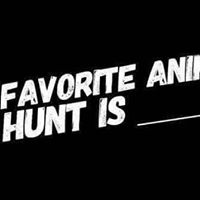 The only way you get in your mind that you hit the spot you can’t go past is a time in the woods. You can watch all the videos you want but when you see what you want, not somebody else, that’s where you have to set up because if you pass it, it’s going to haunt you for the rest of the hunt going, “I should have been there because I knew he’s going to walk by there.” You go back and you check it and there’s a print in the ground and you’re going, “Why did I do that? Why did I doubt myself?”
The only way you get in your mind that you hit the spot you can’t go past is a time in the woods. You can watch all the videos you want but when you see what you want, not somebody else, that’s where you have to set up because if you pass it, it’s going to haunt you for the rest of the hunt going, “I should have been there because I knew he’s going to walk by there.” You go back and you check it and there’s a print in the ground and you’re going, “Why did I do that? Why did I doubt myself?”
Especially hunting on public land, if you’re in there the first time, if you go past something, you almost have to continue on until you find something else you want to hunt. If you walk past 50 to 70 yards, you laid that scent down already. If you back up and hang, a deer might walk out of range smell where you had walked and it’s not going to keep coming down your way. If you’re past something, you might as well keep going until you find something that’s good to hunt that you haven’t walked pass yet. At least, that’s my opinion.
How do you go into public land in the dark and set up looking for scrapes and rub lines, beds and all this stuff? How do you find them in the dark without banging your flashlight all around?
In my morning sets, I like to sit at home or I’m on one of the farms I have permission on because I’m so much more familiar with them. I haven’t set up on public land in the morning because of that. It’s a lot tougher to see. You don’t know that place like the back of your hand. At least, I don’t, not yet. Maybe once I get more familiar with a lot of those spots then I’ll start venturing out in the morning. Being quiet is the key, especially if you’re trying to hunt the deer that’s been hunted before, maybe shot before and lived through it. They’re not going to tolerate any metallic noises or a lot of flashlights shining. They’re going to get up and move. I tried to stick to my home farm and the other farm that I have permission to hunt on when I’m going to go out in the morning. That way I can be a little bit stealthier, a little bit quieter and try to catch him on the way back from food to bed.
When you go out to public land to set up, you go at 1:00 to 3:00. What’s your game plan?
A lot of it has to do with what I got going on that day. I’ve left as early as noon for an evening sit and as late as 3:00. Depending on if I don’t feel like I have a long walk if it’s a spot that I feel is good, that’s pretty close to the parking lot or the truck, then obviously I’ll push that to a little bit later. I would say a lot of times I’m leaving between noon and 1:30 for a sit that is going to end at about 6:00.
If you’ve never been on a piece of public land before, do you park at the parking lot or along the street? We know that from the parking lot, there are people’s trails and it takes a quarter mile or more before those trails dissipate. They start to break off and it’s a cow path. If it isn’t a swamp, it still is a cow path except it’s a wetland.
I park at the parking lot or I’ll dump it off the side of the road if I feel like there’s a spot where I need to get through that’s too far to get to from the parking lot.
You’re parking as a DIY and you got to jump off the road, go to the ditch and headed to your spot. How do you figure the spot? How do you know when you go to the public land where are you going to work? Where are you going to start looking to set up initially?
I’ll always have an idea of looking on the computer. I get on Google Earth or something similar and I’ll pick a tentative spot out of an online map. I park at the parking lot or off on the side of the road somewhere if the parking lot’s not very close. I’ll start to hunt my way in and take my time. If I run into something before, I get there that I feel like I need to hunt then I’ll hang there. Otherwise, I’ll try and get to that spot that I have established what I felt like a good spot to be in at home.
You don’t know if it’s going to take an hour-and-a-half to get to your spot or how do you gauge? It is a swamp and it can mess you up by the depth of the water.
You can get a good idea of what you feel like you’re going to have to walk through. If I feel like I have to go a half-a-mile or three-quarters of a mile, I’ll make that first half of that trip as fast as I can. None at a run or anything but I don’t mind making any noise getting in there because it’s going to be that last couple of hundred yards that you need to be stealthy at. If I don’t think that there’s going to be anything worth hunting within that first half mile, I’ll get through there as quickly as I can. I’m not spending a lot of maybe five to ten minutes getting in that first half-mile. From that point, once I feel like I’m past or into a spot that might hold some deer, then I’ll start to slow down.
With your techniques, how successfully then do you kill a buck every year or every two years?
No, I started to hunt public land. In 2018, I struggled. I wasn’t aggressive enough. If you had asked me if I have bumped to any deer that’s why I felt I wasn’t aggressive enough because I was listening to Dan on a podcast and that was one of the things he said. He’s like, “If you’re not occasionally bumping deer, you’re not pushing the envelope far enough.” I struggled a little bit doing that. I started to get a little bit more selective. I haven’t killed a buck for quite a while. My standards might drop a little bit because I’m starting to get that itch to put something down again but it’s something that I feel like with the amount of scouting that I’ve put in and that I will in the upcoming years, I would like to think that I’d be able to put down a nice buck on public land every other year. That’s a good goal. Every year is unrealistic, especially on public ground and pressured states like Minnesota or Wisconsin. It’s nice to have high goals but you don’t want to be disappointed at the end of the day either.
It’s a chess match. What do you want to leave the audience with about Whitetail Underground?
I’d like to point out that I don’t feel like I’m an expert. I feel like I have some knowledge in a few different areas. It’s me being myself. I’m not trying to push any products on anybody. I’m not sponsored by anyone. You’re not going to get a lot of infomercial type stuff for me. If I use something that’s because I believe in it and I’m not trying to push anything on anybody. I hunt the way I hunt. Everybody’s got to find their own style and at the end of the day, it’s supposed to be fun. If we’re not having fun, we’ve got to change something. It’s hunting. It’s should be done with your family and your friends and we’re making stories. If at the end of the day you’re not having fun, it’s time to change something up, change your style, maybe not put so much pressure on yourself. I’m always trying to keep learning and if I learn something I’ll share it and hopefully, we can interact with each other and grow together.
One more time, how do people get in touch with you on social media?
You can find me on Facebook at Whitetail Underground. I have a YouTube page at Whitetail Underground Productions and I’m on Instagram @Whitetail_Underground. That’s where I’m at. I have a Twitter account but I’m not on there much. It seems like everybody’s on either Facebook or Instagram in the hunting community more often. That’s the two that I’m on the most often.
With that, Eli, thanks so much for joining Whitetail Rendezvous and I can’t wait to get together during the hunting season or right after and find out how the year went. You’ve been a great guest and I appreciate who you are.
I’m glad I was able to be on, Bruce. I appreciate the platform you have and it’s the people that you have on here are knowledgeable. It’s pretty easy to learn a few things.
Important Links:
- Eli – past episode
- Whitetail Underground
- Whitetail Underground Productions – YouTube
- @Whitetail_Underground – Instagram
- Whitetail Underground – Facebook
- The Hunting Beast Forum
- The MeatEater
- American Buffalo: In Search of a Lost Icon
- Behind The Bow
- The Hunting Public
- Twitter – Whitetail Underground
About Eli Gesell
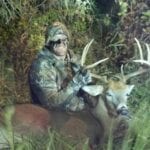 Let me start off by saying I am a father, husband, and a hunter.I still live close to where I grew up in central Minnesota and I love it here. I work a blue collar job and I am proud of where I came from.
Let me start off by saying I am a father, husband, and a hunter.I still live close to where I grew up in central Minnesota and I love it here. I work a blue collar job and I am proud of where I came from.
I have been hunting and fishing since I was 12 with my Dad, Grandpa, and buddies (or anyone who would let me tag along). I grew up on a dairy farm in central Minnesota where I learned that value of hard work, and what it can do for you.
